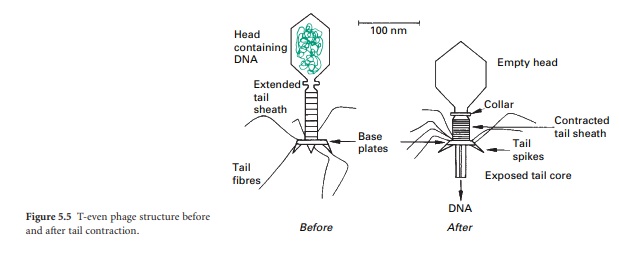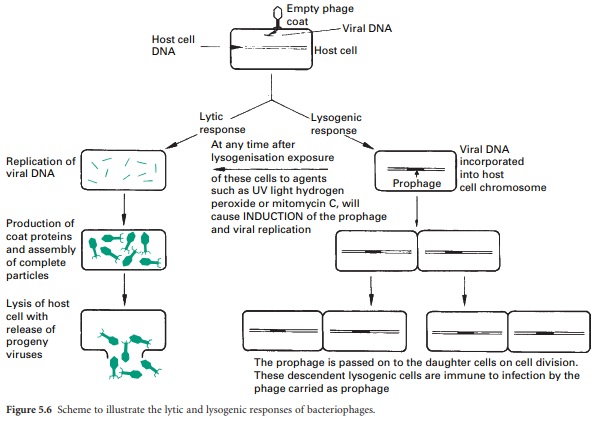Bacteriophages - Viruses as Antimicrobials
| Home | | Pharmaceutical Microbiology | | Pharmaceutical Microbiology |Chapter: Pharmaceutical Microbiology : Viruses
Bacteriophages (phages) are viruses that infect only bacteria. They were first described at the end of the 19th century. They are typically 20–200 nm in size and are highly diverse in their structure and host range and it is likely that all bacterial species can be infected by a phage.
VIRUSES AS ANTIMICROBIALS
BACTERIOPHAGES
Bacteriophages (phages) are
viruses that infect only bacteria. They were first described at the end of the
19th century. They are typically 20–200 nm in size and are highly diverse in
their structure and host range and it is likely that all bacterial species can
be infected by a phage. Phages are extremely specific in their host range and
some will only infect a specific bacterial strain. Such a high specificity is
used for bacterial typing as discussed below. The most studied phages are
complex ones (e.g. T-phage) sometimes referred to as ‘tadpole-shaped’ consisting
of a head (often icosahedral) that contains the viral genome and a tail which
function is to recognize the host receptor, attach and subsequently serve as a
nucleic acid injection device (Figure 5.5). Indeed, one of the main differences
between such phages and common mammalian viruses is that these phages inject
their viral genome inside the host cell.

Phages have proved to be
very useful genetic tools over the years, since they are easy to propagate to
high concentration and easy to study. Because of their similarity to mammalian
viruses, it is not surprising that phages have been used to elucidate the viral
multiplication cycle and their study has led to many discoveries such as mRNA,
the understanding of the genetic code and the control of genes, contributing to
important advances in molecular biology.

From the study of phage
replication cycles, two scenarios have emerged, one resulting in the lysis of
the bacterial host—the lytic cycle—and
the other resulting in the viral nucleic acid being integrated into the host
genome—the lysogenic cycle (Figure
5.6). Infection with a lytic phage, also called virulent phage, results in the replication of the phage within the
susceptible bacteria and the release of infectious phage progeny from the host
cell following cell lysis. Such a lytic property is used to enumerate phages.
Phages inoculated on to a lawn of a susceptible host bacterium form clear ‘holes’
(plaques) which result from phage infection and lysis of a bacterial host and
the release of phage progeny, subsequently infecting, replicating in, and
lysing adjacent cells, ultimately forming these plaques which are easily identifiable with the naked eye (Figure
5.7 ). Since each of these plaques is assumed to result from the infection from
a single phage, the number of plaques counted is used to represent the number
of phages.
In the lysogenic cycle,
the viral nucleic acid which has integrated the host genome is called prophage, and the host cell that
contains the viral genome lysogenic.
Following infection with lysogenic phages, both a lytic and lysogenic responses
are observed. The integration of the prophage ensures that the viral genome is
passed on to the daughter cells following bacterial cell replication. Lysogeny
is an extremely common phenomenon and through evolution most bacteria will host
several prophages. Indeed, sequencing of the whole bacterial genome often
indicates the presence of prophages (or their remnants), that have become
disabled with time. On occasions, a prophage dormant in its host can be reactivated
and resume a lytic cycle. Upon excision from the host genome, the prophage can
take adjacent bacterial genes that become incorporated in the virion and transmitted
to a new susceptible host cell. Genes carried on the prophage can then be expressed
in the new host. This process is called transduction
and is responsible for gene transfer between bacteria. Sometimes, genetic
factors transferred by transduction encode for antibiotic resistant
determinants and/or virulence factors such as toxins. The induction of
prophages to a lytic cycle can be artificially triggered by exposure to
chemical and physical agents such as mitomycin C and ultraviolet light. If the
use of lytic phages might be appropriate to kill bacteria, the use of lysogenic
phages is best confined to the genetic engineering of bacteria.
Related Topics
